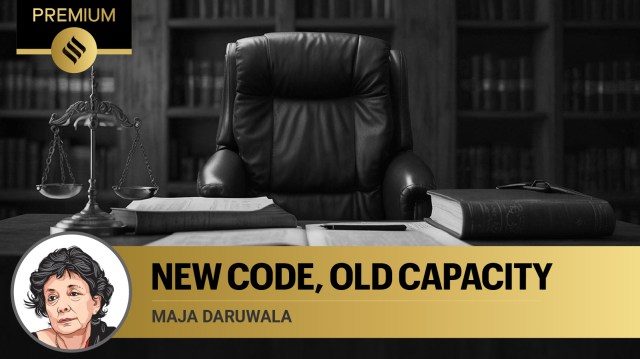
There has been many a furrowed brow and heavy hand on the pen about whether there was a need for a new criminal code, the abbreviated legislative process of its enactment and the content of the Bharatiya Nyaya Sanhita (BNS), Bharatiya Nagarik Suraksha Sanhita (BNSS), and the Bharatiya Sakshya Adhiniyam (BSA). They replace the longstanding IPC, CrPC, and Evidence Act with the stated intention “to safeguard the rights of the public and to eliminate obstacles in the people’s access to those rights” and “adapt them according to present-day needs”. The question now is how to give effect to these new mandates. That remains a matter of immense disquiet.
One of the ambitious aspects of the new laws is the emphasis on speeding up trials. Judgments must now be delivered within 45 days after trial completion, and charges must be framed within 60 days of the first hearing. This raises concerns about the system’s preparedness to cope with the stringent timelines. National Judicial Data Grid (NJDG) data show that 5.1 crore cases are pending across all courts. The workload that averaged 2,391 per judge in 2022 has gone up to 2,474 in 2024. This means trials take longer. The cascading effect is seen in the number of people being held in prisons while awaiting trial or investigation. Between 2020 and 2022, the number of undertrials has gone up from 3.7 lakh to 4.2 lakh.
Concerned that prisoners must be afforded more opportunity for bail, the BNSS now extends the provision of bail, as provided under CrPC’s Section 436A, to allow first-time offenders who have served a third of their sentence to apply for bail. Earlier, this provision, known in the jargon as the “statutory right to bail”, kicked in only after an undertrial had served half of the maximum period of imprisonment. Policy-wise, this shortening of time is welcome. Practice, however, indicates a considerable laxness across the justice system in ensuring that “bail not jail” is a reality, or that the judicial maxim that holds life and liberty “paramount” is honoured.
Several safeguards against unjust incarceration exist within the system. To mention a few — free legal aid and prison visiting lawyers for anyone without representation, undertrial review committees that recommend which inmates could be given bail; State Human Rights Commissions whose members can visit jails anytime to see if there are overstays. However, to come close to making intention a reality — leaving out, for a moment, issues of quality and infrastructure — the entire system, from police to legal aid to the judiciary, will need significant increases in numbers. The India Justice Report records a 21 per cent vacancy in lower courts and a 30 per cent vacancy in high courts. In other words, one in three judges is missing from the bench. Every increase in the number of judges will require a bump up in physical infrastructure and supporting administrative manpower and machinery. Between 2022-23 and 2023-24, budgets for the judiciary have increased but not in proportion to increases in state GDP, nor have they kept up with inflation. A cost-benefit analysis that measures the cost of increasing human resources and infrastructure against the administrative cost of lengthening trials and incarceration seems imperative.
The BNSS also mandates that statements of victims in sexual violence cases must be recorded in the presence of female police officers and must be videographed. It’s uncertain how many complainants would want to be recorded, what that means for privacy if she agrees and what that means for the continuation of the complaint if she refuses.
The mandate assumes women may be more likely to report complaints if a woman is present, though evidence for this is uncertain. Serious logistical challenges are more certain. Despite the sharp rise in gender-based violence cases, only a small percentage of women officers are at ranks qualified to take statements — 80 per cent of women police personnel are in the constabulary. The growing press of cases on a small number of officers can stunt the willingness of victims to come forward and jeopardise the nascent trust being built between victims and law enforcement.
The new laws also mandate forensic investigations for crimes punishable by seven years or more and videography for search and seizures. Failure to comply with these strict requirements can have significant consequences at trial. Chargesheets could be rendered invalid and courts can dismiss cases or exclude evidence if proper procedures are not followed. This is how it should be. The move from coercion towards more rigorous evidence-based law enforcement must be welcomed. However, current capacities to assist law enforcement are wanting by a long measure — a chronic shortage of labs and trained forensic professionals, inadequate infrastructure, mismatches between human resources, equipment and demands from the ground, and of course underfunding. This situation could be exacerbated by the recent legal mandates despite the government’s launch of the National Forensic Infrastructure Enhancement Scheme, which aims to inject Rs 2,254 crore for upgrading and expanding forensic capacities.
The embrace of technology assumes that electronic evidence presented in court is tamper-proof and that the chain of evidence has remained intact as it passes from hand to hand over time. Standards to ensure that the integrity of all kinds of evidence has been maintained will need to be overhauled with rapid changes in technology. Judges will need to be upskilled to be able to provide reasoned decisions for accepting or rejecting its authenticity. They do have the benefit of relying on experts who must be independent, qualified, and available for cross-examination that tests their conclusions.
The success of the new laws hinges on more than addressing structural deficits. It requires comprehensive, across-the-board training to upgrade quality and knowledge and change mindsets. Decades of neglect in training infrastructure requires urgent correction, ensuring that all stakeholders — police, forensic personnel, public prosecutors, defence counsel, and judges — are equipped to apply the law with utmost fairness.
Without urgent attention to these foundational issues, the promise of a faster, more accessible and equitable criminal justice system will wither on the vine.
The writer is Chief Editor, India Justice Report and Senior Advisor, Commonwealth Human Rights Initiative



